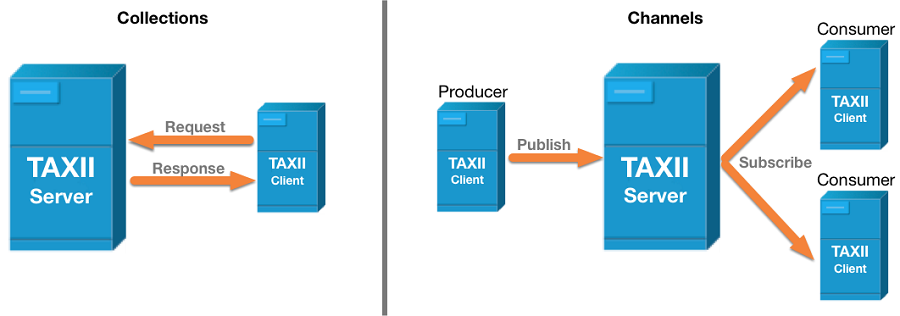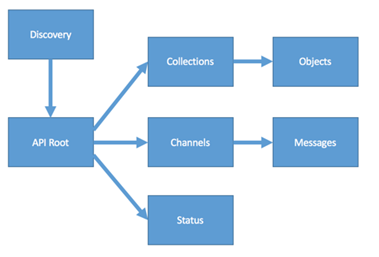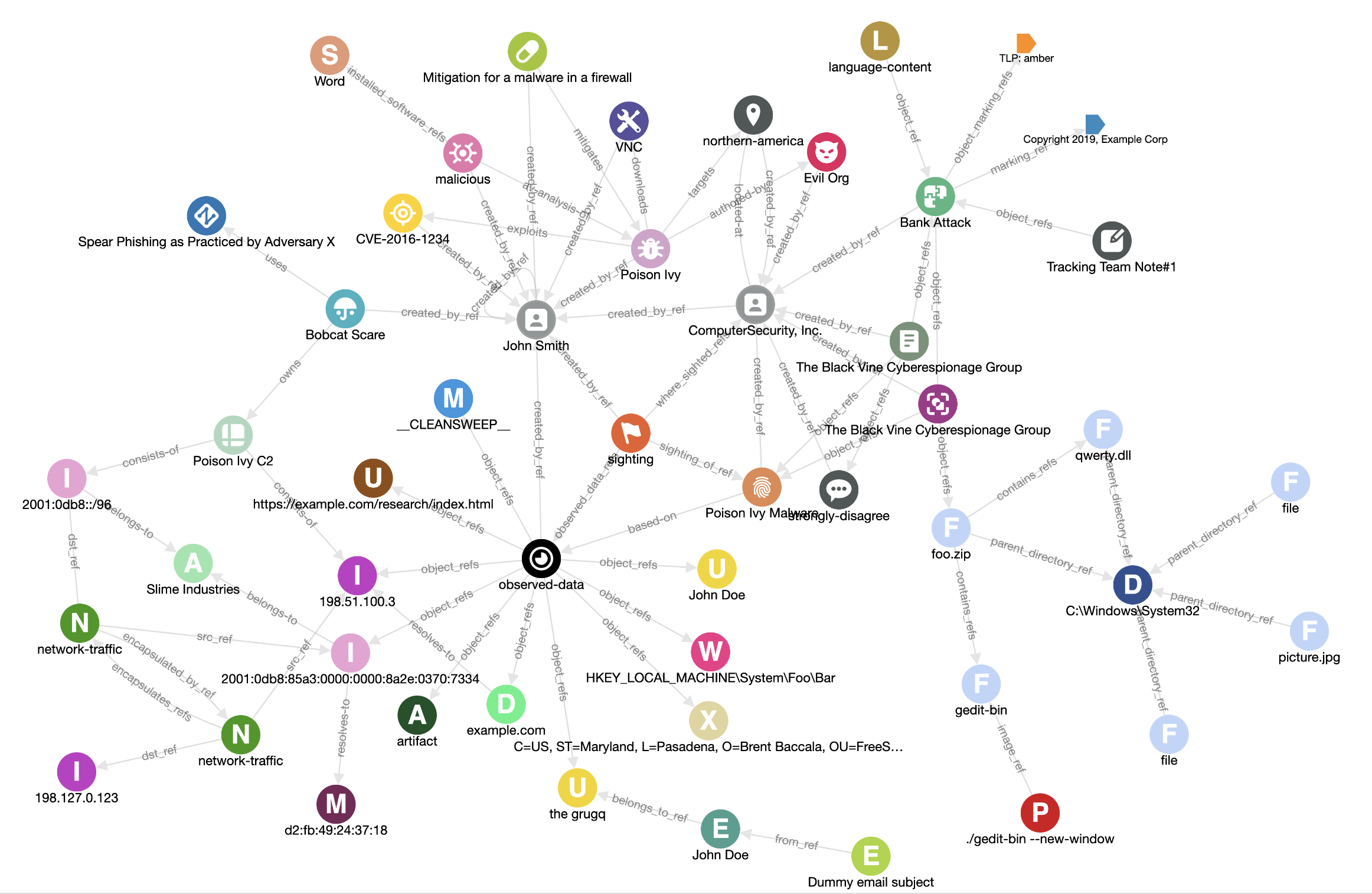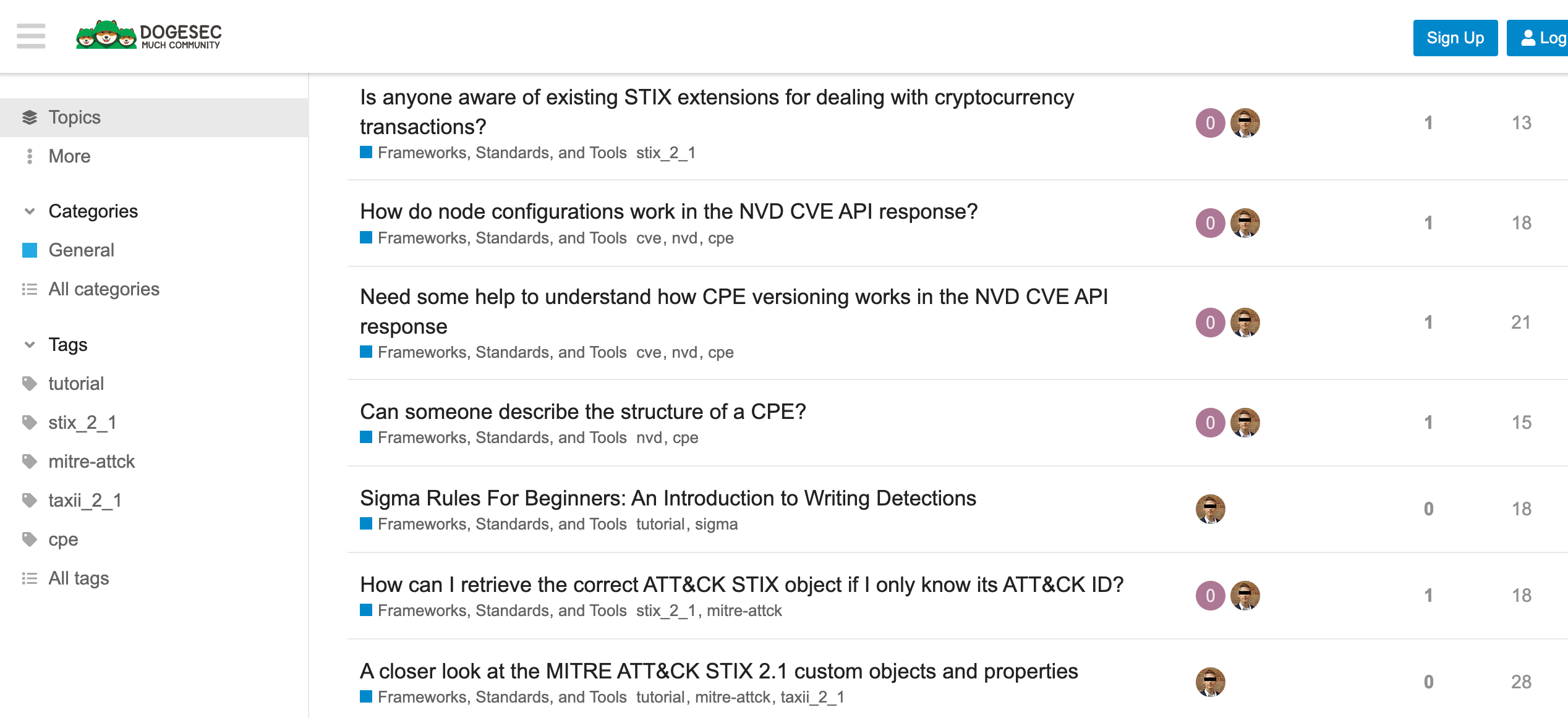If you are reading this blog post via a 3rd party source it is very likely that many parts of it will not render correctly (usually, the interactive graphs). Please view the post on dogesec.com for the full interactive viewing experience.
tl;dr
We built an open-source TAXII server, Arango TAXII Server. Here are some examples of how you can consume data from it using a TAXII Client.
A note for intelligence producers
This post introduces the basics of TAXII. If you want to understand how you can create a TAXII server to share your intelligence to be consumed by TAXII Client (as described in this post), read this post.
An introduction to TAXII
TAXII has two main concepts…
- TAXII Servers: store created intelligence from and disseminate it to consumers (the TAXII Clients) via the API
- TAXII Clients: that publish intelligence and/or consume intelligence from TAXII Servers
- I will cover these in this post, showing you how to interact with our TAXII Server
Note, a TAXII Server and Client can be the same machine (the code supports both Server and Client functionality).
For example, a Threat Intelligence platform acts as a TAXII Client and consumes intelligence feeds from remote TAXII Servers. The TIP also acts a TAXII server for downstream security tools connecting to the TIP to poll for curated intel.
The TAXII 2.1 specification defines two primary services to support a variety of common intelligence sharing models:

- Collections: An interface to a server-provided repository of objects that allows a producer to serve consumers in a request-response template.
- Channels: Allows the exchange of information according to a publish-subscribe model.
For the more technically inclined, a good equivalent is to think of Collections as a REST API and Channels as webhooks.
In reality, the Channels don’t exist. I am not really sure why OASIS decided to include it in the published specification. As such, Channels will be totally ignored in this write up.
Collections and Channels can be organized in different ways.
The search for information on a TAXII server depends on what you are looking for and how you want to receive it. Generally the design of Collections and Channels on a TAXII Server will look something like this:

TAXII Clients contain the logic to consume data from and publish data to Collections (request/response) or Channels (streamed) via the TAXII Servers API.
A TAXII Client might just be a script making API calls to the TAXII Server to retrieve data, though a few fully fledged TAXII Clients with more advanced logic (and a nice user interface) to interact with TAXII APIs exist, some of which I will show you in this tutorial.
Before I get into those, I will demonstrate these concepts by going through the TAXII APIs.
To do this, lets jump right in and install a TAXII Server.
cti-taxii-client
A growing number of cyber security products are introducing native TAXII 2.1 Client functionality to consume cyber threat intelligence from TAXII 2.1 Servers, Microsoft Sentinel, Splunk Enterprise Security, etc.
Not all do though.
In these cases, before you decide to build out all the logic required for a TAXII 2.1 Client into your own product to consume intelligence, there are some existing open-source options you might want to consider, or at least to use for inspiration.
The vendor agnostic option is cti-taxii-client. cti-taxii-client is a client developed by Oasis, and it is probably the best template to use if you plan to build your own TAXII 2.1 Client.
cti-taxii-client is a minimal client implementation for the TAXII 2.X server. It supports the following TAXII 2.0 and 2.1 API services:
- Server Discovery
- Get API Root Information
- Get Status
- Get Collections
- Get a Collection
- Get Objects
- Add Objects
- Get an Object
- Delete an Object (2.1 only)
- Get Object Manifests
- Get Object Versions (2.1 only)
The easiest way to install the TAXII client is with pip:
git clone https://github.com/oasis-open/cti-taxii-client/
cd cti-taxii-client
python3 -m venv cti-taxii-client_env
source cti-taxii-client_env/bin/activate
pip3 install taxii2-client
To test out the TAXII 2.1 Client, you will need a running TAXII 2.1 Server. For this post I will use our TAXII server implementation, arango_taxii_server.
Unlike in this post when I was manually creating curl requests that required me to add the full logic in each request to interact with the TAXII 2.1 Server, a TAXII Client automates all this logic.
cti-taxii-client supports both TAXII 2.0 and TAXII 2.1 in two distinct sub-modules. For this tutorial I will use TAXII 2.1 as most people are using this version (it has been around for 4 years).
In this post I’ll create an example_scripts directory with the contents of these scripts shown in this post. One note, I use the user=read_write_user / password=testing123, you will need to modify these to match your ArangoDB user.
mkdir example_scripts
To begin with I have written a simple Python script that uses the cti-taxii-client library to query the discovery endpoint to find out what is on the server.
# example_scripts/server_discovery.py
import json
import base64
from taxii2client.v21 import Server
# Function to encode user and password in base64
def encode_credentials(user, password):
credentials = f"{user}:{password}"
return base64.b64encode(credentials.encode()).decode()
# Base64 encoded user and password (not needed with taxii2-client)
# encoded_credentials = encode_credentials('read_write_user', 'testing123')
# URL for the TAXII 2.1 server
url = 'http://127.0.0.1:8000/api/taxii2/'
# Create a Server instance
server = Server(url, user='read_write_user', password='testing123')
# Collect server information
server_info = {
'title': server.title,
'description': server.description,
'contact': server.contact,
'custom_properties': server.custom_properties,
'api_roots': [api.url for api in server.api_roots]
}
# Print server information in JSON format
print("Request URL:", url)
print(json.dumps(server_info, indent=4))
python3 example_scripts/server_discovery.py
Which prints;
{
"title": "Arango TAXII Server",
"description": "https://github.com/muchdogesec/arango_taxii_server/",
"contact": "[email protected]",
"api_roots": [
"http://127.0.0.1:8000/api/taxii2/cti_database/",
"http://127.0.0.1:8000/api/taxii2/demo_database/"
]
}
Two api_roots are printed (thus accessible to this user). I can now identify what Collections exist in one of the API Roots (I will use http://127.0.0.1:8000/api/taxii2/cti_database/).
# example_scripts/get_collections.py
import json
import base64
from taxii2client.v21 import ApiRoot
# Function to encode user and password in base64
def encode_credentials(user, password):
credentials = f"{user}:{password}"
return base64.b64encode(credentials.encode()).decode()
# Base64 encoded user and password
encoded_credentials = encode_credentials('read_write_user', 'testing123')
# Set the API root URL
api_root_url = 'http://127.0.0.1:8000/api/taxii2/cti_database/'
# Create an ApiRoot instance with encoded credentials
api_root = ApiRoot(api_root_url, user='read_write_user', password='testing123')
# Collect and print the collection details in JSON format
collections_info = {
'collections': []
}
for collection in api_root.collections:
collection_info = {
'title': collection.title,
'description': collection.description,
'id': collection.id,
'custom_properties': collection.custom_properties,
'can_read': collection.can_read,
'can_write': collection.can_write,
'media_types': collection.media_types,
}
collections_info['collections'].append(collection_info)
# Print the collections information in JSON format
print(json.dumps(collections_info, indent=4))
python3 example_scripts/get_collections.py
{
"collections": [
{
"id": "yara_rules",
"title": "yara_rules",
"description": "vertex+edge",
"can_read": true,
"can_write": true,
"media_types": [
"application/stix+json;version=2.1"
]
},
{
"id": "mitre_attack_enterprise",
"title": "mitre_attack_enterprise",
"description": "vertex+edge",
"can_read": true,
"can_write": true,
"media_types": [
"application/stix+json;version=2.1"
]
},
{
"id": "mitre_attack_mobile",
"title": "mitre_attack_mobile",
"description": "vertex+edge",
"can_read": true,
"can_write": true,
"media_types": [
"application/stix+json;version=2.1"
]
},
{
"id": "mitre_attack_ics",
"title": "mitre_attack_ics",
"description": "vertex+edge",
"can_read": true,
"can_write": true,
"media_types": [
"application/stix+json;version=2.1"
]
}
Now I can start to discover the Objects held by each of these Collections. I will use mitre_attack_enterprise to demonstrate.
# example_scripts/get_objects.py
import json
from taxii2client.v21 import ApiRoot
# Create an ApiRoot instance with correct URL and credentials
api_root_url = 'http://127.0.0.1:8000/api/taxii2/cti_database/'
api_root = ApiRoot(api_root_url, user='read_write_user', password='testing123')
# Dictionary to hold collections
collections_dict = {}
# Iterate over collections in the specified API root
try:
for collection in api_root.collections:
collections_dict[collection.id] = collection
except Exception as e:
print(f"Error processing API root {api_root.url}: {e}")
# Get the specific collection by ID
collection_id = 'mitre_attack_enterprise'
collection = collections_dict.get(collection_id)
if collection:
# Retrieve objects from the collection
stix_objects = collection.get_objects()
# Print the STIX objects in JSON format
print(json.dumps(stix_objects, indent=4))
else:
print(f"Collection with ID {collection_id} not found.")
{
"more": true,
"next": 34617997,
"objects": [
{
"x_mitre_domains": [
"enterprise-attack"
],
"object_marking_refs": [
"marking-definition--fa42a846-8d90-4e51-bc29-71d5b4802168"
],
"id": "course-of-action--797312d4-8a84-4daf-9c56-57da4133c322",
"type": "course-of-action",
"created": "2018-10-17T00:14:20.652Z",
"created_by_ref": "identity--c78cb6e5-0c4b-4611-8297-d1b8b55e40b5",
"external_references": [
{
"source_name": "mitre-attack",
"url": "https://attack.mitre.org/mitigations/T1199",
"external_id": "T1199"
}
],
"modified": "2019-07-25T12:30:35.417Z",
"name": "Trusted Relationship Mitigation",
"description": "Network segmentation can be used to isolate infrastructure components that do not require broad network access. Properly manage accounts and permissions used by parties in trusted relationships to minimize potential abuse by the party and if the party is compromised by an adversary. Vet the security policies and procedures of organizations that are contracted for work that require privileged access to network resources.",
"x_mitre_deprecated": true,
"x_mitre_version": "1.0",
"x_mitre_modified_by_ref": "identity--c78cb6e5-0c4b-4611-8297-d1b8b55e40b5",
"spec_version": "2.1",
"x_mitre_attack_spec_version": "2.1.0"
},
{
"x_mitre_domains": [
"enterprise-attack"
],
"object_marking_refs": [
"marking-definition--fa42a846-8d90-4e51-bc29-71d5b4802168"
],
"id": "course-of-action--7a14d974-f3d9-4e4e-9b7d-980385762908",
"type": "course-of-action",
"created": "2018-10-17T00:14:20.652Z",
"created_by_ref": "identity--c78cb6e5-0c4b-4611-8297-d1b8b55e40b5",
"external_references": [
{
"source_name": "mitre-attack",
"url": "https://attack.mitre.org/mitigations/T1073",
"external_id": "T1073"
}
],
"modified": "2019-07-24T14:24:44.818Z",
"name": "DLL Side-Loading Mitigation",
"description": "Update software regularly. Install software in write-protected locations. Use the program sxstrace.exe that is included with Windows along with manual inspection to check manifest files for side-loading vulnerabilities in software.",
"x_mitre_deprecated": true,
"x_mitre_version": "1.0",
"x_mitre_modified_by_ref": "identity--c78cb6e5-0c4b-4611-8297-d1b8b55e40b5",
"spec_version": "2.1",
"x_mitre_attack_spec_version": "2.1.0"
},
{
"x_mitre_domains": [
"enterprise-attack"
],
"object_marking_refs": [
"marking-definition--fa42a846-8d90-4e51-bc29-71d5b4802168"
],
"id": "course-of-action--7a4d0054-53cd-476f-88af-955dddc80ee0",
"type": "course-of-action",
"created": "2018-10-17T00:14:20.652Z",
"created_by_ref": "identity--c78cb6e5-0c4b-4611-8297-d1b8b55e40b5",
"external_references": [
{
"source_name": "mitre-attack",
"url": "https://attack.mitre.org/mitigations/T1189",
"external_id": "T1189"
},
{
"url": "https://blogs.windows.com/msedgedev/2017/03/23/strengthening-microsoft-edge-sandbox/",
"description": "Cowan, C. (2017, March 23). Strengthening the Microsoft Edge Sandbox. Retrieved March 12, 2018.",
"source_name": "Windows Blogs Microsoft Edge Sandbox"
},
{
"url": "https://arstechnica.com/information-technology/2017/03/hack-that-escapes-vm-by-exploiting-edge-browser-fetches-105000-at-pwn2own/",
"description": "Goodin, D. (2017, March 17). Virtual machine escape fetches $105,000 at Pwn2Own hacking contest - updated. Retrieved March 12, 2018.",
"source_name": "Ars Technica Pwn2Own 2017 VM Escape"
},
{
"url": "https://blogs.technet.microsoft.com/srd/2017/08/09/moving-beyond-emet-ii-windows-defender-exploit-guard/",
"description": "Nunez, N. (2017, August 9). Moving Beyond EMET II \u2013 Windows Defender Exploit Guard. Retrieved March 12, 2018.",
"source_name": "TechNet Moving Beyond EMET"
},
{
"url": "https://en.wikipedia.org/wiki/Control-flow_integrity",
"description": "Wikipedia. (2018, January 11). Control-flow integrity. Retrieved March 12, 2018.",
"source_name": "Wikipedia Control Flow Integrity"
}
],
"modified": "2019-07-24T19:14:33.952Z",
"name": "Drive-by Compromise Mitigation",
"description": "Drive-by compromise relies on there being a vulnerable piece of software on the client end systems. Use modern browsers with security features turned on. Ensure all browsers and plugins kept updated can help prevent the exploit phase of this technique.\n\nFor malicious code served up through ads, adblockers can help prevent that code from executing in the first place. Script blocking extensions can help prevent the execution of JavaScript that may commonly be used during the exploitation process.\n\nBrowser sandboxes can be used to mitigate some of the impact of exploitation, but sandbox escapes may still exist. (Citation: Windows Blogs Microsoft Edge Sandbox) (Citation: Ars Technica Pwn2Own 2017 VM Escape)\n\nOther types of virtualization and application microsegmentation may also mitigate the impact of client-side exploitation. The risks of additional exploits and weaknesses in implementation may still exist. (Citation: Ars Technica Pwn2Own 2017 VM Escape)\n\nSecurity applications that look for behavior used during exploitation such as Windows Defender Exploit Guard (WDEG) and the Enhanced Mitigation Experience Toolkit (EMET) can be used to mitigate some exploitation behavior. (Citation: TechNet Moving Beyond EMET) Control flow integrity checking is another way to potentially identify and stop a software exploit from occurring. (Citation: Wikipedia Control Flow Integrity) Many of these protections depend on the architecture and target application binary for compatibility.",
"x_mitre_deprecated": true,
"x_mitre_version": "1.0",
"x_mitre_modified_by_ref": "identity--c78cb6e5-0c4b-4611-8297-d1b8b55e40b5",
"spec_version": "2.1",
"x_mitre_attack_spec_version": "2.1.0"
},
I’ve cut down the response for brevity in this post because it contains 50 responses per page.
You will also see that I need to introduce some pagination logic into the script if I want to obtain all the objects. The TAXII Client ships with a Class (as_pages) for TAXII 2.1 endpoints that support pagination.
In this script I also use the limit URL parameter (set to 1) to only return one result per page, to show what pagination looks like. The following script prints the response from the first two pages.
# example_scripts/get_objects_paginated.py
from taxii2client.v21 import as_pages, Server
import json
# Create a Server instance with correct URL and credentials
server = Server('http://127.0.0.1:8000/api/taxii2/', user='read_write_user', password='testing123')
# Dictionary to hold collections
collections_dict = {}
# Iterate over API roots and collections
for api_root in server.api_roots:
try:
for collection in api_root.collections:
collections_dict[collection.id] = collection
except Exception as e:
print(f"Error processing API root {api_root.url}: {e}")
continue
# Get the specific collection by ID
collection_id = 'mitre_attack_enterprise'
collection = collections_dict.get(collection_id)
if collection:
page_no = 1
for envelope in as_pages(collection.get_objects, per_request=1): # Limit set to 1
print(f'\nPage # {page_no}')
# Parse the envelope as JSON
stix_objects = envelope
# Pretty-print the STIX objects
print(json.dumps(stix_objects, indent=4))
if page_no >= 2: # Show only the first 2 pages
break
page_no += 1
else:
print(f"Collection with ID {collection_id} not found.")
python3 example_scripts/get_objects_paginated.py
Page # 1
{
"more": true,
"next": "46984006_undef+0.22373385850816663",
"objects": [
{
"x_mitre_domains": [
"enterprise-attack"
],
"object_marking_refs": [
"marking-definition--fa42a846-8d90-4e51-bc29-71d5b4802168"
],
"id": "course-of-action--797312d4-8a84-4daf-9c56-57da4133c322",
"type": "course-of-action",
"created": "2018-10-17T00:14:20.652Z",
"created_by_ref": "identity--c78cb6e5-0c4b-4611-8297-d1b8b55e40b5",
"external_references": [
{
"source_name": "mitre-attack",
"url": "https://attack.mitre.org/mitigations/T1199",
"external_id": "T1199"
}
],
"modified": "2019-07-25T12:30:35.417Z",
"name": "Trusted Relationship Mitigation",
"description": "Network segmentation can be used to isolate infrastructure components that do not require broad network access. Properly manage accounts and permissions used by parties in trusted relationships to minimize potential abuse by the party and if the party is compromised by an adversary. Vet the security policies and procedures of organizations that are contracted for work that require privileged access to network resources.",
"x_mitre_deprecated": true,
"x_mitre_version": "1.0",
"x_mitre_modified_by_ref": "identity--c78cb6e5-0c4b-4611-8297-d1b8b55e40b5",
"spec_version": "2.1",
"x_mitre_attack_spec_version": "2.1.0"
}
]
}
Page # 2
{
"more": true,
"next": "46984006_undef+0.19274094492717542",
"objects": [
{
"x_mitre_domains": [
"enterprise-attack"
],
"object_marking_refs": [
"marking-definition--fa42a846-8d90-4e51-bc29-71d5b4802168"
],
"id": "course-of-action--7a14d974-f3d9-4e4e-9b7d-980385762908",
"type": "course-of-action",
"created": "2018-10-17T00:14:20.652Z",
"created_by_ref": "identity--c78cb6e5-0c4b-4611-8297-d1b8b55e40b5",
"external_references": [
{
"source_name": "mitre-attack",
"url": "https://attack.mitre.org/mitigations/T1073",
"external_id": "T1073"
}
],
"modified": "2019-07-24T14:24:44.818Z",
"name": "DLL Side-Loading Mitigation",
"description": "Update software regularly. Install software in write-protected locations. Use the program sxstrace.exe that is included with Windows along with manual inspection to check manifest files for side-loading vulnerabilities in software.",
"x_mitre_deprecated": true,
"x_mitre_version": "1.0",
"x_mitre_modified_by_ref": "identity--c78cb6e5-0c4b-4611-8297-d1b8b55e40b5",
"spec_version": "2.1",
"x_mitre_attack_spec_version": "2.1.0"
}
]
}
You can see the more pages exist each time because more is set to true. The next page id, which the TAXII client (as_pages) uses to move to the next page, is defined in the next property.
Of course one of the other key functions is filtering – I don’t always want all objects returned. This script filters by the match[id] URL parameter for the object course-of-action--7c1796c7-9fc3-4c3e-9416-527295bf5d95:
# example_scripts/get_objects_filtered.py
from taxii2client.v21 import Server
import json
# Create a Server instance with correct URL and credentials
server = Server('http://127.0.0.1:8000/api/taxii2/', user='read_write_user', password='testing123')
# Dictionary to hold collections
collections_dict = {}
# Iterate over API roots and collections
for api_root in server.api_roots:
try:
for collection in api_root.collections:
collections_dict[collection.id] = collection
except Exception as e:
print(f"Error processing API root {api_root.url}: {e}")
continue
# Get the specific collection by ID
collection_id = 'mitre_attack_enterprise'
collection = collections_dict.get(collection_id)
if collection:
try:
# Retrieve a specific object by ID
stix_object = collection.get_object(obj_id='course-of-action--7c1796c7-9fc3-4c3e-9416-527295bf5d95')
# Print the STIX object in JSON format
print(json.dumps(stix_object, indent=4))
except Exception as e:
print(f"Error retrieving object from collection: {e}")
else:
print(f"Collection with ID {collection_id} not found.")
python3 example_scripts/get_objects_filtered.py
{
"more": false,
"objects": [
{
"x_mitre_domains": [
"enterprise-attack"
],
"object_marking_refs": [
"marking-definition--fa42a846-8d90-4e51-bc29-71d5b4802168"
],
"id": "course-of-action--7c1796c7-9fc3-4c3e-9416-527295bf5d95",
"type": "course-of-action",
"created": "2018-10-17T00:14:20.652Z",
"created_by_ref": "identity--c78cb6e5-0c4b-4611-8297-d1b8b55e40b5",
"external_references": [
{
"source_name": "mitre-attack",
"url": "https://attack.mitre.org/mitigations/T1043",
"external_id": "T1043"
},
{
"source_name": "University of Birmingham C2",
"description": "Gardiner, J., Cova, M., Nagaraja, S. (2014, February). Command & Control Understanding, Denying and Detecting. Retrieved April 20, 2016.",
"url": "https://arxiv.org/ftp/arxiv/papers/1408/1408.1136.pdf"
}
],
"modified": "2019-07-24T14:17:58.966Z",
"name": "Commonly Used Port Mitigation",
"description": "Network intrusion detection and prevention systems that use network signatures to identify traffic for specific adversary malware can be used to mitigate activity at the network level. Signatures are often for unique indicators within protocols and may be based on the specific protocol used by a particular adversary or tool, and will likely be different across various malware families and versions. Adversaries will likely change tool C2 signatures over time or construct protocols in such a way as to avoid detection by common defensive tools. (Citation: University of Birmingham C2)",
"x_mitre_deprecated": true,
"x_mitre_version": "1.0",
"x_mitre_modified_by_ref": "identity--c78cb6e5-0c4b-4611-8297-d1b8b55e40b5",
"spec_version": "2.1",
"x_mitre_attack_spec_version": "2.1.0"
}
]
}
You can see 'more': False indicating no more pages of objects.
By default, the latest version of the object will always be printed unless you ask for specific versions. So lets write a script that checks for versions of this object.
# example_scripts/get_object_versions.py
from taxii2client.v21 import Server, as_pages
import json
# Create a Server instance with correct URL and credentials
server = Server('http://127.0.0.1:8000/api/taxii2/', user='read_write_user', password='testing123')
# Dictionary to hold collections
collections_dict = {}
# Iterate over API roots and collections
try:
for api_root in server.api_roots:
for collection in api_root.collections:
collections_dict[collection.id] = collection
except Exception as e:
print(f"Error while retrieving collections: {e}")
exit()
# Define the collection ID and object ID
collection_id = 'mitre_attack_enterprise'
obj_id = 'course-of-action--7c1796c7-9fc3-4c3e-9416-527295bf5d95'
# Retrieve the specific collection by ID
collection = collections_dict.get(collection_id)
if collection:
page_no = 1
try:
for envelope in as_pages(collection.object_versions, obj_id=obj_id, per_request=50):
print(f'\nPage # {page_no}')
# Parse the envelope as JSON
versions = envelope # `envelope` is already in JSON format
# Pretty-print the STIX object versions
print(json.dumps(versions, indent=4))
page_no += 1
except Exception as e:
print(f"Error retrieving or processing object versions: {e}")
else:
print(f"Collection with ID {collection_id} not found.")
python3 example_scripts/get_object_version.py
{
"more": false,
"next": null,
"versions": [
"2018-01-17T12:56:55.080Z",
"2018-04-18T17:59:24.739Z",
"2018-10-17T00:14:20.652Z",
"2019-07-24T14:17:58.966Z"
]
}
The version returned earlier was the latest 2019-07-24T14:17:58.966Z. Lets instead request the earliest 2018-01-17T12:56:55.080Z.
# example_scripts/get_object_version_oldest.py
from taxii2client.v21 import Server
import json
# Create a Server instance with correct URL and credentials
server = Server('http://127.0.0.1:8000/api/taxii2/', user='read_write_user', password='testing123')
# Dictionary to hold collections
collections_dict = {}
# Iterate over API roots and collections
for api_root in server.api_roots:
try:
for collection in api_root.collections:
collections_dict[collection.id] = collection
except Exception as e:
print(f"Error processing API root {api_root.url}: {e}")
continue
# Get the specific collection by ID
collection_id = 'mitre_attack_enterprise'
collection = collections_dict.get(collection_id)
if collection:
try:
# Retrieve a specific version of an object by ID and version
object_id = 'course-of-action--7c1796c7-9fc3-4c3e-9416-527295bf5d95'
version = '2018-01-17T12:56:55.080Z'
stix_object = collection.get_object(obj_id=object_id, version=version)
# Print the STIX object in JSON format
print(json.dumps(stix_object, indent=4))
except Exception as e:
print(f"Error retrieving object from collection: {e}")
else:
print(f"Collection with ID {collection_id} not found.")
{
"more": false,
"next": null,
"objects": [
{
"created": "2018-01-17T12:56:55.080Z",
"created_by_ref": "identity--c78cb6e5-0c4b-4611-8297-d1b8b55e40b5",
"description": "Network intrusion detection and prevention systems that use network signatures to identify traffic for specific adversary malware can be used to mitigate activity at the network level. Signatures are often for unique indicators within protocols and may be based on the specific protocol used by a particular adversary or tool, and will likely be different across various malware families and versions. Adversaries will likely change tool C2 signatures over time or construct protocols in such a way as to avoid detection by common defensive tools. (Citation: University of Birmingham C2)",
"external_references": [
{
"source_name": "mitre-attack",
"url": "https://attack.mitre.org/wiki/Technique/T1043",
"external_id": "T1043"
},
{
"source_name": "University of Birmingham C2",
"description": "Gardiner, J., Cova, M., Nagaraja, S. (2014, February). Command & Control Understanding, Denying and Detecting. Retrieved April 20, 2016.",
"url": "https://arxiv.org/ftp/arxiv/papers/1408/1408.1136.pdf"
}
],
"id": "course-of-action--7c1796c7-9fc3-4c3e-9416-527295bf5d95",
"modified": "2018-01-17T12:56:55.080Z",
"name": "Commonly Used Port Mitigation",
"spec_version": "2.1",
"type": "course-of-action",
"x_mitre_attack_spec_version": "2.1.0",
"x_mitre_domains": [
"enterprise-attack"
],
"x_mitre_modified_by_ref": "identity--c78cb6e5-0c4b-4611-8297-d1b8b55e40b5",
"x_mitre_version": "1.0"
}
]
}
cti-taxii-client also supports the publishing of Objects (add_objects). You can pass the STIX Objects using .add_objects.
I use a new API root and collection for this request. You’ll also see I post the same object (by id) three times. This demonstrates how versioning works as three versions of this object will be created as the modified time increases between the objects.
# example_scripts/add_objects.py
from taxii2client.v21 import Server
import json
import requests
from requests.auth import HTTPBasicAuth
# Create a Server instance with correct URL and credentials
server = Server('http://127.0.0.1:8000/api/taxii2/', user='read_write_user', password='testing123')
# Dictionary to hold collections
collections_dict = {}
# Iterate over API roots and collections
for api_root in server.api_roots:
try:
for collection in api_root.collections:
collections_dict[collection.id] = collection
except Exception as e:
print(f"Error processing API root {api_root.url}: {e}")
continue
# Get the specific collection by ID
collection_id = 'blog'
collection = collections_dict.get(collection_id)
if collection:
try:
# JSON object to be added to the collection
objects_to_add = {
"objects": [
{
"type": "attack-pattern",
"spec_version": "2.1",
"id": "attack-pattern--6b948b5a-3c09-5365-b48a-da95c3964cb5",
"created_by_ref": "identity--d2916708-57b9-5636-8689-62f049e9f727",
"created": "2020-01-01T11:21:07.478851Z",
"modified": "2020-01-01T11:21:07.478851Z",
"name": "Spear Phishing",
"description": "Used for tutorial content",
"object_marking_refs": ["marking-definition--34098fce-860f-48ae-8e50-ebd3cc5e41da"]
},
{
"type": "attack-pattern",
"spec_version": "2.1",
"id": "attack-pattern--6b948b5a-3c09-5365-b48a-da95c3964cb5",
"created_by_ref": "identity--d2916708-57b9-5636-8689-62f049e9f727",
"created": "2020-01-02T11:21:07.478851Z",
"modified": "2020-01-02T11:21:07.478851Z",
"name": "Spear Phishing Updated ONCE",
"description": "Used for tutorial content",
"object_marking_refs": ["marking-definition--34098fce-860f-48ae-8e50-ebd3cc5e41da"]
},
{
"type": "attack-pattern",
"spec_version": "2.1",
"id": "attack-pattern--6b948b5a-3c09-5365-b48a-da95c3964cb5",
"created_by_ref": "identity--d2916708-57b9-5636-8689-62f049e9f727",
"created": "2020-01-03T11:21:07.478851Z",
"modified": "2020-01-03T11:21:07.478851Z",
"name": "Spear Phishing Updated TWICE",
"description": "Used for tutorial content",
"object_marking_refs": ["marking-definition--34098fce-860f-48ae-8e50-ebd3cc5e41da"]
}
]
}
# Prepare the headers
headers = {
'Content-Type': 'application/taxii+json;version=2.1',
'Accept': 'application/taxii+json;version=2.1'
}
# Print the request URL and headers
request_url = collection.url + 'objects/'
print(f"Request URL: {request_url}")
print("Request Headers:", json.dumps(headers, indent=4))
# Make the request using requests library
response = requests.post(
request_url,
headers=headers,
auth=HTTPBasicAuth('read_write_user', 'testing123'),
json=objects_to_add
)
# Print the response in JSON format
print(json.dumps(response.json(), indent=4))
except Exception as e:
print(f"Error adding objects to the collection: {e}")
else:
print(f"Collection with ID {collection_id} not found.")
Remember, you must have can_write permissions to the collection to add / delete objects from it using TAXII.
This script responds as follows;
{
"id": "da62e209-cf48-40f3-a687-b89b0cde5546",
"status": "pending",
"total_count": 3,
"success_count": 0,
"successes": [],
"failure_count": 0,
"failures": [],
"pending_count": 3,
"pendings": [
{
"message": null,
"version": "2020-01-01T11:21:07.478Z",
"id": "attack-pattern--6b948b5a-3c09-5365-b48a-da95c3964cb5"
},
{
"message": null,
"version": "2020-01-02T11:21:07.478Z",
"id": "attack-pattern--6b948b5a-3c09-5365-b48a-da95c3964cb5"
},
{
"message": null,
"version": "2020-01-03T11:21:07.478Z",
"id": "attack-pattern--6b948b5a-3c09-5365-b48a-da95c3964cb5"
}
],
"request_timestamp": "2024-06-18T09:48:30.879800Z"
}
If I use the get_object_versions.py script but use the id attack-pattern--6b948b5a-3c09-5365-b48a-da95c3964cb5 (in place of course-of-action--7c1796c7-9fc3-4c3e-9416-527295bf5d95) I get the following;
{
"more": false,
"next": null,
"versions": [
"2020-01-01T11:21:07.478Z",
"2020-01-02T11:21:07.478Z",
"2020-01-03T11:21:07.478Z"
]
}
Finally, delete operations are also covered by cti-taxii-client. Here I delete the object I just created, and all versions of it (attack-pattern--6b948b5a-3c09-5365-b48a-da95c3964cb5);
# example_scripts/delete_object.py
from taxii2client.v21 import Server, Collection
import requests
from requests.auth import HTTPBasicAuth
# Create a Server instance with correct URL and credentials
server = Server('http://127.0.0.1:8000/api/taxii2/', user='read_write_user', password='testing123')
# Dictionary to hold collections
collections_dict = {}
# Iterate over API roots and collections
for api_root in server.api_roots:
try:
for collection in api_root.collections:
collections_dict[collection.id] = collection
except Exception as e:
print(f"Error processing API root {api_root.url}: {e}")
continue
# Get the specific collection by ID
collection_id = 'blog'
collection = collections_dict.get(collection_id)
if collection:
try:
# Prepare the headers
headers = {
'Content-Type': 'application/taxii+json;version=2.1',
'Accept': 'application/taxii+json;version=2.1'
}
# Define the object ID to be deleted
object_id = 'attack-pattern--6b948b5a-3c09-5365-b48a-da95c3964cb5'
# Print the request URL and headers
request_url = f"{collection.url}objects/{object_id}/"
print(f"Request URL: {request_url}")
print("Request Headers:", json.dumps(headers, indent=4))
# Make the DELETE request using requests library
response = requests.delete(
request_url,
headers=headers,
auth=HTTPBasicAuth('read_write_user', 'testing123')
)
# Check for successful deletion
if response.status_code == 200:
print('Successfully deleted')
else:
print(f"Failed to delete. Status code: {response.status_code}")
print(response.text)
except Exception as e:
print(f"Error deleting object from the collection: {e}")
else:
print(f"Collection with ID {collection_id} not found.")
Which prints;
Successfully deleted
In summary
Hopefully some of these demo scripts have given you a brief overview of how a TAXII client works under the hood. The scripts are far from perfect, nor have I covered all the features of cti-taxii-client.
As cti-taxii-client is a minimal implementation, there are some functions missing. That said, it is still a great starting point to build off or to use for testing the responses from a TAXII Server.
Cyber Threat Exchange
The worlds largest intelligence sharing community. Subscribe to selected intelligence producers, and curate and share your own cyber threat intelligence.

Discuss this post
Head on over to the dogesec community to discuss this post.

Never miss an update
Sign up to receive new articles in your inbox as they published.
